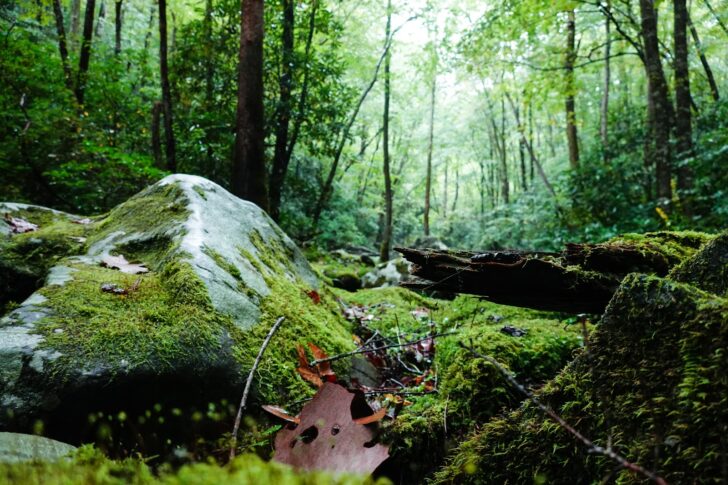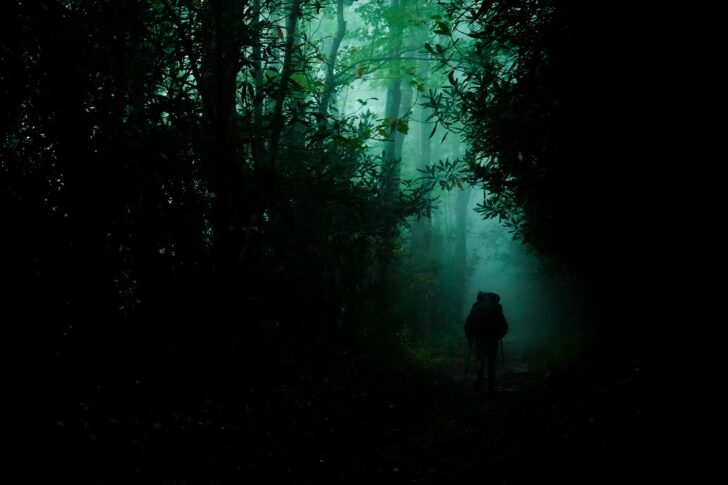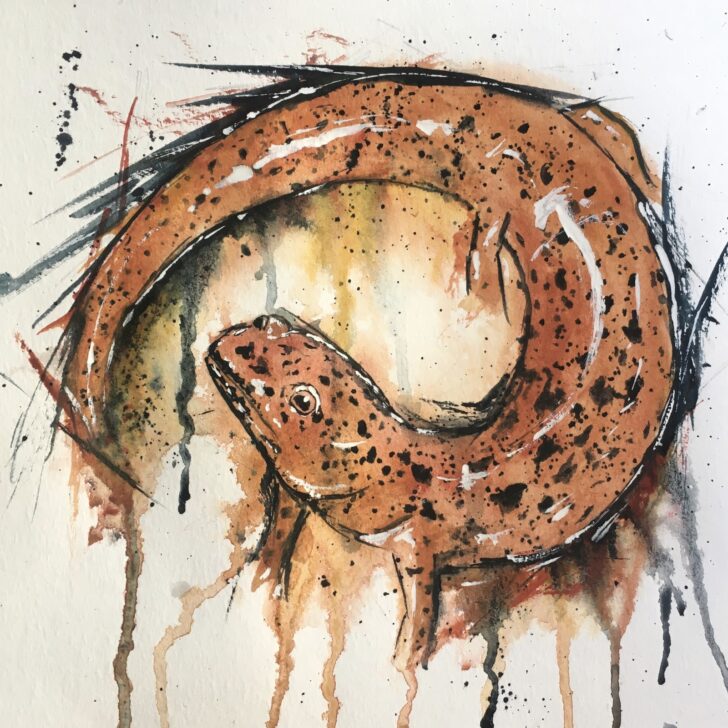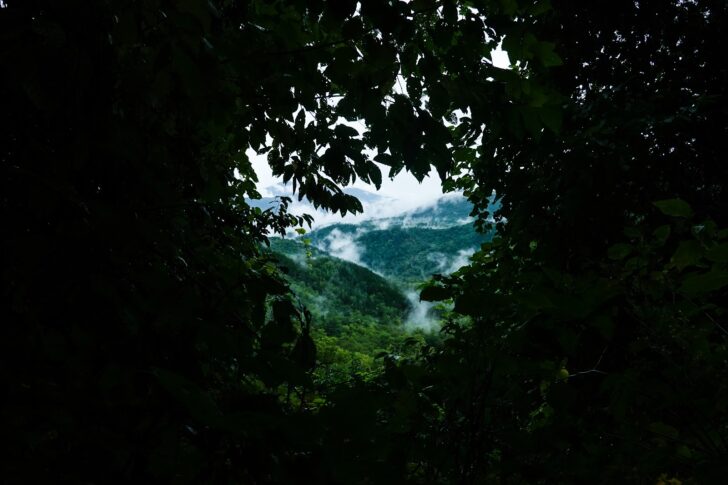There are salamanders in the Great Smoky Mountains that breathe entirely through their skin.
I think this is a wonderful fact. It makes me deeply happy that the grinding, unstoppable force of evolution came up with both gills and lungs but still wanted a weird little side project like skin breathing. Evolution, it should be said, is only slightly less prolific than Dolly Parton, another child of the Smokies. Dolly is currently enjoying something like her 1,000th career resurgence. Would that salamanders were so durable.
Parton grew up in a little town called Pigeon Forge, in the shadow of Pigeon Mountain where, as it turns out, there’s a species of salamander that lives just on that one hillside. So, maybe there’s just something about the Smokies that encourages creative mastery, be it by singer-songwriters or science in action.

I grew up in the general vicinity of the southern Appalachians, but unlike the Pigeon Mountain salamander, I have lived in many places. Currently, I live in California, where a well-chosen curse word and a light breeze can start a fire that chars half the state. It was the smoke from these fires that canceled a long-planned trip on the Wonderland Trail, a famously beautiful loop route around the base of Mt. Rainier in Washington State.
In the days leading up to the trip, my hiking partner Nick and I had been keeping a close eye on the air pollution levels in the Pacific Northwest, hoping that the right combination of wind and rain would send the smoke billowing in a different direction. Wonderland Trail permits are awarded by lottery, and the self-supported loop-style trip was the perfect Covid-19-safe itinerary. We were loathe to cancel our plans. But conditions continued to worsen, and with three days until our prospective start, we pulled the plug.
It was heartbreaking, but in classic 2020 fashion, not surprising. With only 72 hours to find another 100-plus-mile (160+ km) loop route in a non-on-fire part of the country, we drew a more or less random circle around the Great Smoky Mountain National Park and applied for permits. The park made an ideal plan B, with something like 900 miles of trails available to choose from. I also happened to have an unavoidable family commitment back east at around the same time, so I was forced to brave the airports one way or the other.
On the Wonderland Trail, you can cache food, meaning you don’t have to carry so much at a time. We’d have no such luck in the Smokies, so we started chucking luxury items out of our packs to make room for four more days of vittles.
The Rainforest of the South
48 hours later, we were in the park. I felt my sinuses begin to rehydrate about five minutes after crossing the park boundary. I breathed deeply as we walked, relishing the smoke-free air. We had a short day heading east along Fontana Lake and made camp with plenty of daylight to spare. We fell asleep to the sound of cicadas and frogs waging a sonic war in the canopy around us. It’s the sound I most deeply associate with my childhood. Between that and the assurance that, for the first time in three months, I wasn’t in immediate danger of evacuating in advance of a wildfire, I slept better than I had in a long, long time.

A few hours later, it started to rain. Water falling from the sky. Moisture in the air.
What a concept.
Salamander Daydreams
We spent our second day hiking along Lakeshore Trail, still heading east, and more or less hugging the shores of Fontana Lake. We’d woken to a gentle drizzle and made breakfast under the DCF tarp we’d tossed into my pack at the last minute. It would be the first of the roughly 6,000 times we’d eat under it in the seven days to follow.

Lakeshore Trail is part of the Benton MacKaye trail system, a medium-distance trail (300 mi / 483 km) that winds from the western side of North Carolina to Springer Mountain in North Georgia. It was going to be my hiking project for March of 2020. In fact, the weekend that Covid-19 went from “somewhat concerning” to a “national emergency” was the weekend I was going to fly east to begin hiking. A familiar story to anyone who’s had hiking plans disrupted this year. How weird to find myself on this trail, if only for a few days, six months later.
As the managing editor at Backpacking Light, I come into contact with a lot of elite hiking athletes. I am most assuredly not an elite hiking athlete, but interviewing the likes of Jeff Garmire multiple times puts unhealthy FKT-related thoughts into my type-A brain. As we squelched along on the Benton MacKaye Trail, I began to daydream about setting an FKT on it. After I returned home, I looked up the current record. I’d have to run it and average 55+ mile (88 km) days.
Nevermind.
We finally left the lake and turned northeast to climb into the mountains proper by the afternoon of day three. When I’d crawled out of my tent at 6 AM that morning, I’d been greeted by several crawdads scampering around outside my vestibule. You know you are hiking in a temperate rainforest when the freshwater crustaceans come out to play on what is ostensibly dry land.

We ate lunch on a narrow ridgeline with no room for the tarp. Rain splashed spicy-ramen juice into my eyes. Our day contained no less than twelve rain-swollen fords. I was—unapologetically— having a blast.
The rain petered out by the afternoon, but the trees, ferns, and vines continued to splash us every time a light breeze kicked up through the poplars, beeches, and birches. We ate dinner by headlamp. I sat my mug down on the damp soil and turned away for a moment. When I picked it back up seconds later, it had sprouted a salamander as if by magic. Her eyes blazed in the reflected light from my headlamp. I gently scooched her away with damp, muddy fingers.

The southern Appalachians are an incredibly biodiverse ecosystem. The general scientific consensus is that the ice-age glaciers pushed a variety of species further and further south, and all those species just hung around after the glaciers retreated. It’s a particularly good spot for salamanders, as I noted earlier. There are more unique species of salamanders in the southern Appalachians than anywhere in the world, including the hellbender—an amazing specimen that can reach up to two feet (61 cm) long and weighs more than a large kitten. Only two species of Asian salamanders are larger.
Hellbenders have picked up a few colloquial names over the centuries, my favorite being the Snot Dragon. In the cold, damp, late fall air, our noses ran consistently. We took to saying “all hail the Snot Dragon” every time we sent a snot rocket flying into the surrounding mountain laurel.
Hobbit Pipes and Bourbon Songs
The next morning we slept in, had a leisurely breakfast, and luxuriated in the relative dryness of the day. It was just over twelve miles (19 km) to our next campsite, and we took advantage of the extra time to take a long lunch and air out some gear. But in the southern Appalachians, things only get so dry. We considered ourselves lucky to get our clothes, quilts, and skin from saturated to moderately damp. It was the right moment to enjoy a pipe, hobbit-like, propped up against a tree.

We climbed up above 4,000 feet (1,219 m), watched the ecosystem start to change to spruce-forest, then descended once more to maples, oaks, birches, and our campsite.
When we arrived at our designated site, it already contained another camper. We chatted in the way that folks do in such situations, and he poured a measure of bourbon into our mugs as we ate dinner. As we sipped our shots, he put a serious dent in the amber liquid sloshing around in the bottom of his nearly empty flask. Soon enough he was waxing eloquent about his recently finalized divorce.
He was awake and singing drunkenly to himself long into the night, only just audible over the ever-present frog song. I couldn’t make out the words, but the tune sounded improbably like a sea shanty.
Mulberry Place
A 22 mile (35 km) day took us over Clingman’s Dome. It was the second time I’d been there—the first was on my thru-hike of the Appalachian Trail in 2012. That’s the year Superstorm Sandy came through and dumped three feet (91 cm) of snow onto the Smokies in early October, just as I was passing through wearing Chacos and kilt, possessing no insulating body fat, and carrying a forty-degree quilt in my pack.

Now, as it was then, the overlook was socked in with fog and mist, a complete whiteout. I took a photo comprised entirely of white fog and later sent it to my dad with the caption, “classic Smoky Mountain vista.” He appreciated it—he had roamed the Smokies with his father back in the early seventies.
The Appalachian Trail above 6,000 feet (1,829 km) on the Dome is mystical, cloud-shrouded, and holy—the home of the White Bear in Cherokee history. Stand around long enough, and you are sure to grow some moss in your beard. The mountain’s real name is Kuwa’hi, or “Mulberry Place” in Cherokee. Under the United States’ stewardship, the Frasier firs and giant hemlocks that tower above the unique ecosystem are crashing to the ground—the victims of invasive insects and blight. The great chestnuts of the lower elevations have been gone for years. Before 1906, 25% of the trees in the Appalachian mountains were American Chestnuts. All gone now, dead to an airborne bark fungus accidentally imported from Asia at the turn of the century.

As for the Cherokee, they’ve mostly been gone since the late 1830s, when the Jackson administration ignored a supreme court ruling and removed the Cherokee and other Indigenous People from the area by force, bartering, bribes, and political pressure (source: Jacksonland, by Steve Inskeep).
The south has no monopoly on racism, ignorance, bigotry, broken promises, and genocide. But those things feel immediate there—renewed and refreshed every time a Confederate flag is waved or you realize a street in your hometown is named after the first grand wizard of the Klu Klux Klan.
Every now and then, someone will ask me where I grew up. My hillbilly accent has mostly been washed away by stints in Ohio, Texas, and California, and it isn’t always obvious. When I tell them where I’m from, the usual response is, “Oh, I’m sorry.”
I never know how to feel about this. I usually settle on a mix of shame and irritation, like when you complain about your parents and then your partner chips in with a complaint of her own. With Georgia in the national news more or less non-stop for the last two years, that feeling has been leaning more and more towards shame. Ultimately, we own the places that make us, whether we like it or not. I’ve spent the better part of my adult life vacillating between being happy I no longer live in the south and wondering if it’s possible to move back and use my voice and vote and privilege as a straight white man to make it—at least in some small ways—a better place.
I don’t have a resolution for this, and eight days of walking through my home mountain range didn’t provide one.
We Go Up. We Go Down. We Cross a Stream.
We recovered from our long climb over Kuwa’hi by sleeping in and doubling our breakfast rations. As we ate in the morning drizzle, salamanders watched us from atop logs, underneath flaps of moss, and beneath rocks. It reminded me of canoeing through the Okefenokee—the enormous swamp that occupies the lower corner of Georgia and the upper corner of Florida. In the Okefenokee Swamp, there are enough alligators around that you are always within the gaze of one, much as New Yorkers are generally always pretty close to a rat.
I imagine the same is true of the Smokies and salamanders. There’s just something about the collective gaze of a dozen cold-blooded creatures that makes the monkey in me want to head for the nearest tree, even if the creatures in question are rarely larger than a pencil.

We had another short day mostly free of rain—though we still passed through the occasional cloud as we climbed and descended back and forth over the ridgeline that forms the spine of the park. As a cloud is just rain that hasn’t gotten its life together yet, the end result was more or less the same.
The last few miles seemed interminable despite our short hiking time. Ahead of me, I could hear Nick mumbling to himself, “We go up. We go down. We cross a stream. We go up. We go down. We cross a stream. We go up. We go down. We cross a stream.” It’s the kind of trekking that can and has driven east coast hikers quietly insane. My quasi-zen comments about walking being the point of walking didn’t seem to help, but that’s to be expected on empty stomachs and wet feet.

We set up our tarp quickly and shoveled down some tepid food. Thunder echoed over the ridges and hollows, and an opaque sheet of rain quickly followed. We heard it barreling through the forest towards us—a steam train with no engine, just a rushing tide of mist condensing inevitably into rain. Water doing what it does. Being inevitable.
We dove into our shelters just as it hit. The atmosphere in my tent was only .005% dryer than the air outside. I spared a moment of pity for my down quilt as the force of the falling rain sent condensation splashing all around me. I pulled the wet sack of feathers over my head and slept deeply, even after realizing that my air mattress had sprung a catastrophic leak.
When we awoke, it was still thundering. Occasional bursts of lightning illuminated the rivulets of water carving micro-canyons through our campsite. We hunkered down under the tarp; drinking endless cups of coffee and smoking our pipes while we waited on the worst of the lightning to pass. When it finally did, we set out into the rain.
All Hail the Snot Dragon
As the day wore on, Nick’s pace slowed, especially on the downhills. At lunch, we assessed the damage. His knees were in rough shape after seven days of relentless climbing and descending. No one likes to bail on a route, but we decided to shave a few miles and one day off our hike. We changed our plan slightly to follow the AT back down to Fontana Dam the next day. The terrain was tough enough that we’d be risking a more serious injury to Nick’s knees if we continued with our planned route—one wrong step on a slippery root, and he’d be in for ACL surgery.

At camp that night, I identified the hole in my sleeping pad and attempted a field repair. I sacrificed my last semi-dry piece of clothing to dry the area around the hole and patch it with the included kit. Then I slapped some Tenacious Tape on top of the repair for good measure. I went to sleep feeling fairly confident but woke up a few hours later with my butt on the cold, damp earth. My legs and head were still elevated under a cushion of air, so I’d at least managed to slow the leak. It was good enough. I went back to sleep.
In a turn of events that every serious backpacker will recognize, our last day in the Smokies had the most agreeable weather by far. The temperatures were crisp, the sky blue, the maples just starting to turn. We worked our way down, down, down the ridgeline of the AT, finally catching glimpses of Fontana Lake as the miles slid away beneath our feet and the afternoon light softened.

Within an hour of the car, we came to a rocky outcropping that offered a glimpse of the mountains unfolding in hazy layers to the horizon.
As we admired our first and only scenic vista of the trip, Nick opened his precious final pack of pop tarts, and I unsealed my last packet of strawberry lemonade drink mix. Both items were were sodden—somehow, the Smokies had managed to saturate them through heat-sealed Mylar. We ate both things anyway, then made our way out of the mountains. In the fading light, I took a last glimpse around for salamanders, hoping my headlamp would spark in a pair of strange, alien eyes. No luck. I made a final offering anyway, pinching one nostril shut and sending a final snot rocket into the thick, fragrantly rotting pile of leaves at my feet.
All hail the Snot Dragon. May her skin be moist, may her streams be cold and clear, and may her offspring number in the millions.

Related Content
Essays by Andrew Marshall
Reviews by Andrew Marshall
DISCLOSURE (Updated April 9, 2024)
- Product mentions in this article are made by the author with no compensation in return. In addition, Backpacking Light does not accept compensation or donated/discounted products in exchange for product mentions or placements in editorial coverage. Some (but not all) of the links in this review may be affiliate links. If you click on one of these links and visit one of our affiliate partners (usually a retailer site), and subsequently place an order with that retailer, we receive a commission on your entire order, which varies between 3% and 15% of the purchase price. Affiliate commissions represent less than 15% of Backpacking Light's gross revenue. More than 70% of our revenue comes from Membership Fees. So if you'd really like to support our work, don't buy gear you don't need - support our consumer advocacy work and become a Member instead. Learn more about affiliate commissions, influencer marketing, and our consumer advocacy work by reading our article Stop wasting money on gear.




Home › Forums › Salamander Song